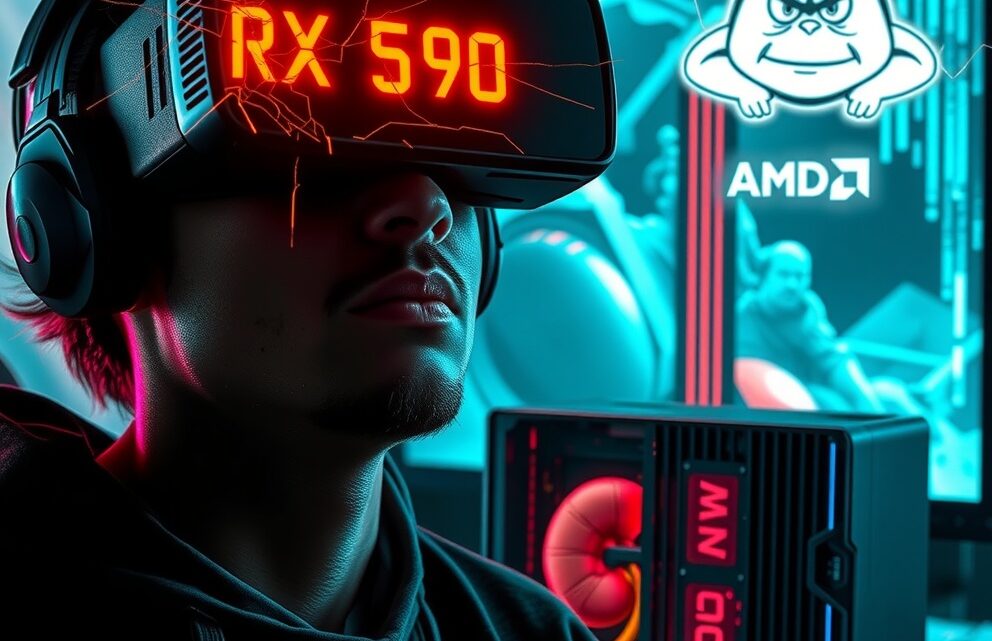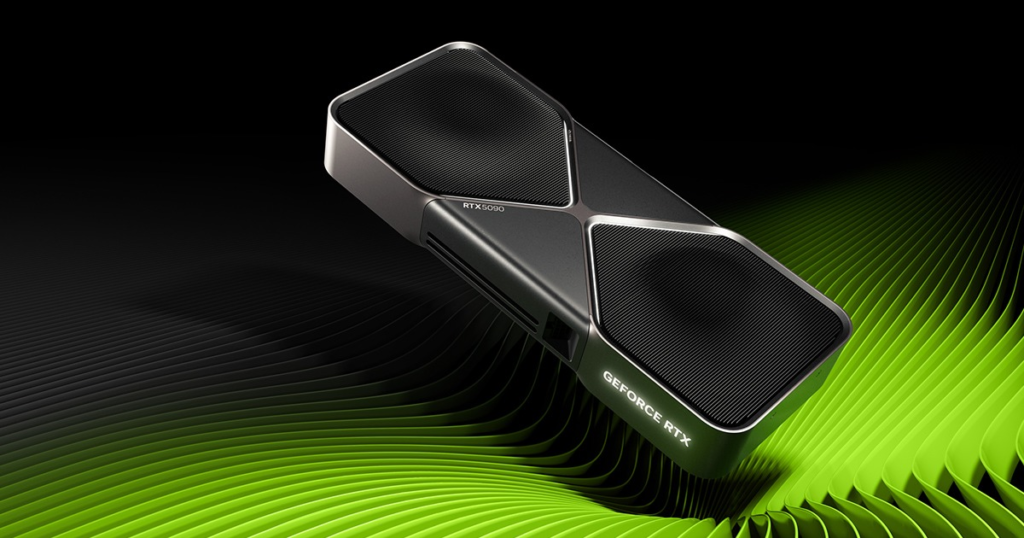
NVIDIA GeForce RTX 590 Review: Performance, DLSS 4 & Price Analysis
September 21, 2025NVIDIA GeForce RTX 590 Review: Performance, DLSS 4 & Price Analysis
In an era where graphics processing units (GPUs) have become the cornerstone of both gaming and professional computing, NVIDIA’s latest release—the GeForce RTX 590—has ignited a wave of excitement and skepticism. Priced at a staggering $2,000 but with a unique proposition: your least favorite kidney, this GPU is more than just another hardware iteration; it’s a glimpse into the future of performance and AI integration in consumer-grade graphics cards.
But before we dive into speculation about kidneys or the ethical implications (or lack thereof) of such an exchange, let’s take a step back and analyze what makes the RTX 590 truly groundbreaking—and why it might not be as revolutionary as some are expecting.
A New Architecture: Neural Rendering
At the heart of the RTX 590 is NVIDIA’s new Blackwell architecture, which they’ve boldly rebranded not as a GPU architecture, but as a Neural Rendering Architecture. This shift in terminology might raise eyebrows, especially for those familiar with the more traditional classifications used by competitors like AMD.
In essence, Blackwell introduces a host of features that blend traditional rendering techniques with AI-driven enhancements, particularly through NVIDIA’s Tensor Cores and RT Cores. The fifth-generation Tensor Cores are optimized for DLSS 4, which we’ll dive into shortly, while the fourth-gen RT Cores now double the ray-triangle intersection rate using just 75% of the memory footprint compared to previous generations.
This is a significant leap forward in rendering efficiency, especially in ray tracing and AI-assisted upscaling. However, as NVIDIA’s own benchmarks suggest, these improvements come at a cost—both in price and in terms of real-world performance gains relative to its predecessor, the RTX 4090.
Performance: A Tale of Two Realms
When it comes to gaming performance, the RTX 590 delivers on paper but falls short when compared to expectations. At 1440p, the card performs marginally better than the RTX 4090 in some titles—like *Red Dead Redemption 2* and *F1 24*—but only by about 10% or less. Even more concerning is its performance against the Radeon RX 7900 XTX, which, while priced around half of what the RTX 590 costs, offers a 30% lead in *Black Myth: Wukong*, making it a formidable contender for budget-conscious gamers.
At 4K, however, things shift. The RTX 590 finally shows its potential by being the first card to crack triple digits at ultra settings in *Cyberpunk 2077*. But even then, its average frame rate barely hits 60 FPS in *Black Myth: Wukong*, which is a bit of a disappointment for a flagship product. The RTX 590 also struggles with CPU bottlenecks, especially when paired with older CPUs like the AMD Ryzen 7000 series.
DLSS 4 and Multiframe Gen: A Game-Changer?
NVIDIA has always been at the forefront of AI-assisted rendering, and the RTX 590 introduces two key enhancements to their DLSS (Deep Learning Super Sampling) technology: DLSS 4 and Multiframe Generation.
DLSS 4
The new DLSS 4 is powered by a shift from CNNs (Convolutional Neural Networks) to Transformer-based models, which allows for better understanding of entire frames rather than just individual pixels. This results in smoother edges, reduced ghosting, and more consistent performance—especially in fast-paced or complex scenes.
However, the improvements are not immediately noticeable on a visual level. Side-by-side comparisons with DLSS 3 show only marginal differences in image quality but notable gains in stability and motion fidelity. This is both a win and a slight misstep, as many users might expect more dramatic changes for such a significant leap in AI models.

Multiframe Gen (MFG)
Perhaps the most talked-about feature of the RTX 590 is Multiframe Gen, which allows the card to generate up to three intermediate frames per native frame—effectively quadrupling the FPS count. In theory, this should be a game-changer for low-end hardware or budget setups.
But in practice, MFG introduces visible artifacts and latency issues that can significantly detract from immersion. For example, in *Cyberpunk 2077*, there are noticeable combing effects on crosswalks, bottle phasing, and even a strange doubling of fan blades in *Alan Wake 2*. These artifacts occur more frequently when MFG is active, which is the opposite of what we expect from AI-driven upscaling.
Despite these issues, NVIDIA claims that MFG doesn’t add any extra latency compared to native frame rates—something we confirmed through our latency tests using Reflex. However, even if the latency is consistent, the visual anomalies are still a concern for gamers who value realism over raw FPS numbers.
Productivity and AI Workloads: A New Frontier?
While the RTX 590 may not be a game-changer in gaming performance, it’s undeniably powerful when it comes to productivity workloads, especially those involving AI training and inference. The inclusion of 32 GB of VRAM is a major boon for AI professionals, as well as a potential game-changer for gamers who want to run high-resolution 4K streams or render complex scenes with minimal lag.
NVIDIA has also upgraded the video encoding and decoding hardware, offering support for 4:2:2 chroma sampling, which is essential for professional video editors. This upgrade could potentially offer up to a 9% boost in Premiere Pro performance and even more impressive gains in DaVinci Resolve, according to early benchmarks.
In terms of AI benchmarking, the RTX 590 shows strong performance, especially in FP4 precision mode, where it outperforms its predecessor by nearly 75%. However, when compared to the RTX 3090 Ti, it still only offers a modest 20–30% improvement—which is not as dramatic as one might expect from such a powerful card.
Thermal and Power Design: A Bold Move
NVIDIA has taken a different approach with the RTX 590’s cooling system, which features a unique dual-flow design using flexible PCBs to route power and data through daughterboards. This allows for better airflow through dense heat sinks, although it also adds complexity to system builds.
In terms of power consumption, the RTX 590 is no slouch—drawing up to 637 watts during peak load, with an average of around 554 watts in real-world gaming scenarios. This is a significant jump from previous generations and could be a concern for users on tight power budgets or those building compact systems.
Price vs. Performance: A Stupider Card?
One of the most controversial aspects of the RTX 590 is its price point, which sits at $2,000—a steep increase over the RTX 4090’s $1,600 price tag and a 25% hike compared to previous models. While the card does offer a 30–35% performance boost in most benchmarks, many users are questioning whether this is worth the additional cost.
In terms of value for money, the RTX 590 falls short compared to AMD’s offerings, which continue to provide better performance per dollar—especially when ray tracing and upscaling are not required. However, it still holds its ground in AI workloads, where its 32 GB VRAM and enhanced encoder/decoder hardware give it a clear advantage over the competition.
The Future: What’s Next?
Despite the RTX 590’s shortcomings, it represents an important step forward for NVIDIA—especially with the introduction of DLSS 4 and MFG, which could have long-term implications for both gaming and AI development. While these technologies are still in their infancy and suffer from some visual artifacts, they point to a future where AI-driven rendering becomes more seamless and efficient.
That said, unless semiconductor manufacturing sees a significant breakthrough in cost reduction, the days of dramatic performance improvements with each new GPU generation may be over. Instead, we might see companies like NVIDIA focus on smaller incremental upgrades with enhanced AI capabilities rather than outright performance leaps.

Conclusion: A Mixed Bag
The NVIDIA GeForce RTX 590 is undeniably one of the most powerful consumer GPUs to date—especially in AI and productivity workloads. However, its performance per dollar ratio remains a concern, especially when compared to AMD’s offerings or even its own predecessor.
For professional gamers, developers, and AI enthusiasts, the RTX 590 is a must-have. But for the average gamer, it may not be worth the price unless you’re looking for that extra edge in competitive multiplayer or running high-end streaming setups.
In short, while the RTX 590 is an impressive piece of hardware with significant potential, it’s still more of a stupider card than its predecessor, and one that may not live up to the hype for all users.
For those interested in learning more about this review or exploring NVIDIA’s full lineup of GPUs, you can visit the official source: NVIDIA GeForce RTX 590 Review.
Wow, the RTX 590 is an absolute powerhouse! As a developer who’s been pushing AI and rendering workflows for years, I can say this card is a game-changer for productivity and AI workloads. The Blackwell architecture combined with DLSS 4? That’s next-level performance that makes me excited to see what the future holds.
But here’s something fascinating—how do you think NVIDIA will address those visual artifacts in MFG without sacrificing performance? It feels like we’re on the brink of a new era where AI and graphics converge, and I can’t wait to see how this evolves!
Wow, Ashton, you’re really selling that Blackwell architecture as if it’s not just a fancy word for “we shuffled some silicon and called it progress.” But hey, who am I to doubt someone who’s been “pushing AI and rendering workflows” since the last ice age?
As for NVIDIA fixing those visual artifacts without sacrificing performance—good luck with that. We’re all just one step away from a world where AI doesn’t hallucinate entire universes just to render a slightly less blurry texture. You know, if we can ever get past the fact that “next-level” is just a marketing term for “we added more buzzwords.”
But hey, if you’re excited about the future of AI and graphics converging… enjoy it while it lasts. I’m over here still waiting for my 2015 GPU to finally stop pretending it’s not running a ray-traced simulation in 4K.
With such power comes such price—how long before we see more affordable options with similar AI capabilities? It’s thrilling to imagine what the future holds, especially with DLSS 4 making every frame smoother than ever. The RTX 590 is proof that NVIDIA isn’t just innovating—they’re leading the charge into a new era of computing!
The performance benchmarks are eye-opening too. Even though it falls short in some areas compared to AMD’s offerings, when you factor in productivity gains and AI enhancements, it’s hard not to be excited. This card is clearly aimed at professionals who need every ounce of power available. Can we expect similar AI-driven breakthroughs from other GPU manufacturers soon?
I’m also blown away by the neural rendering concept—it’s a whole new level of immersion for gamers and creators alike! The integration of Tensor Cores with traditional rendering techniques feels like a glimpse into what’s coming next. It’s not just about raw power anymore; it’s about how that power is used to create richer, more lifelike experiences.
This review has me buzzing with anticipation for the future of AI-integrated GPUs. Whether you’re gaming at 4K or rendering complex scenes, the RTX 590 shows what’s possible when hardware and software align perfectly. The only thing left now is to see how this sets the stage for the next generation!